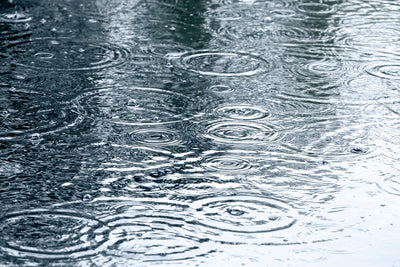What You Need To Know About PFAS Chemicals in Rainwater
RSS
Christina Liu and Emily Driehaus | Hydroviv Science Team
Researchers across the country have begun studying the presence of PFAS chemicals in rainwater. This phenomenon comes at a time when Congress and health officials are making important decisions about this toxic contaminant. PFAS or ‘forever chemicals’ are now believed to be present in all major U.S. water supplies. Our team discusses everything you need to know about the most recent research and what PFAS in rainwater means for you.
What Are PFAS?
Per and Polyfluoroalkyl Substances (PFAS) are a category of emerging contaminants commonly used in firefighting foam, Teflon, non-stick or stain-resistant surfaces, and food packaging. PFAS exposure is associated with various adverse health effects, including an increased risk of cancer, lowered fertility rates, and developmental issues in infants and young children. GenX, PFOA, and PFOS are all common contaminants that fall under the category of PFAS. PFAS use a carbon-fluorine bond, which is one of the strongest chemical bonds and extremely difficult to break down in the environment. The Department of Defense has acknowledged that “no satisfactory disposal method has been identified” for PFAS mitigation and “many likely byproducts will be environmentally unsatisfactory.”
Where Do PFAS Compounds Come From?
PFAS compounds have been used since the 1950s in industrial and consumer products including Scotchgard, Teflon, firefighting foam, metal plating, heat/water repellent products, stain resistant fabrics, carpets, non-stick pans, paints, polishes, waxes, cleaning products, and food packaging. Firefighters and the military use fire-suppressing foam, which are associated with this category of contaminants.
PFAS contamination in groundwater was first reported in 2001. Although PFOS was no longer manufactured in the US after 2002 and PFOA was no longer manufactured in the US after 2015, the presence of these “forever chemicals” in the environment remains.
Are There PFAS Chemicals in Rainwater?
Studies conducted between 2006-2018 on precipitation across the Great Lakes showed that PFAS was detected in rainwater and other precipitation.
Researchers at the University of Wisconsin and the National Atmospheric Deposition Program (NADP) collected 37 rainwater samples from 30 sites across the country in 2019. The team found that all of the samples were contaminated with at least one of 36 variations of PFAS compounds that they tested for.
The Integrated Atmospheric Deposition Network (IADN), a long-term Great Lakes monitoring program jointly funded by the U.S. Environmental Protection Agency and Canada, is currently studying PFAS in precipitation (snow and rain) across the Great Lakes. At each testing site, PFAS was the major contaminant, as there were more PFAS in the samples than other pollutants like polychlorinated biphenyls (PCB) and polycyclic aromatic hydrocarbons (PAH).
Scientists from the College of Wooster in Ohio presented a study in April 2021 showing that high levels of PFOA and PFOS were detected in rainwater even several years after they were no longer manufactured or used in the United States. Kyndalanne Pike, the lead author of the study, said that these results surprised her since PFOA and PFOS have been phased out in manufacturing.
“I expected to see more PFBA than maybe PFOA and PFOS because PFBA has been brought in as a substitute,” she said. “We expected PFOA and PFOS to have kind of tapered down because of the stewardship program, and we were just surprised by its persistence in the environment after all these years.”
Pike’s samples came from areas in Ohio and Indiana, which have both been heavily dominated by the manufacturing industry. The team also collected samples from a remote area in Wyoming to use as a reference point. However, Pike found that the levels of PFAS from certain sites in Ohio were not significantly different from those levels in Wyoming, highlighting the impact of weather on PFAS pollution.
“I don’t think we can downplay the impact of weather patterns,” Pike said. “Even in these incredibly remote places, like they’ve sampled snow in the Alps, and they’ll find PFAS.”
Should I Worry About Getting Wet In the Rain?
Researchers from the IADN study from Indiana University said that “people don’t need to worry about becoming stain-resistant after being out in the rain.” The primary concern for humans continues to be exposure through ingestion rather than dermal exposure. The contaminated precipitation does, nonetheless, spread the PFAS chemicals around the environment where they can build up in the plants, wildlife, and bodies of water. Pike said that since rain is very dilute, the amount of PFAS in rainwater is not likely to cause any problems, but the presence of PFAS in rainwater indicates how widespread PFAS pollution is.
“Rain shows the persistence of PFAS,” she said. “If we’re seeing parts per trillion to kind of low parts per billion concentrations of PFAS in rainwater, that should kind of scare us. These aren’t scary concentrations of PFAS, but if it’s getting that high in rainwater, what kind of concentrations are we seeing in the groundwater or wherever the water originated?” Researchers are continuing to analyze PFAS in rainwater in hopes of tracing them back to specific polluters, and they also intend to study the seasonal trends of PFAS concentration.
How Can Hydroviv Help Me?
Hydroviv is a water filtration company that uses water quality data to optimize water filters for each customer's water. Major “points of emphasis” that we use to build water filters include PFAS, as well as Lead, Arsenic, Radium, Uranium, Chromium 6, Disinfection Byproducts, and VOCs. We provide formulations specifically for water in your location, but all of our filters also include broad protection against a wide range of contaminants. Questions? Email hello@hydroviv.com.
Hydroviv's drinking water filters carry NSF certifications to Standard 42 (aesthetic effects--Chlorine Removal) and Standard 53 (health effects--Lead, VOCs, and PFOA/PFOS removal), and are independently tested to remove hundreds of contaminants.
Other Articles You Might Enjoy:PFAS: Everywhere We Look, We Find It.
What You Need To Know About Surface Water Contamination
PFAS Update: Do New Infrastructure Bills Address “Forever Chemicals” In Drinking Water?




